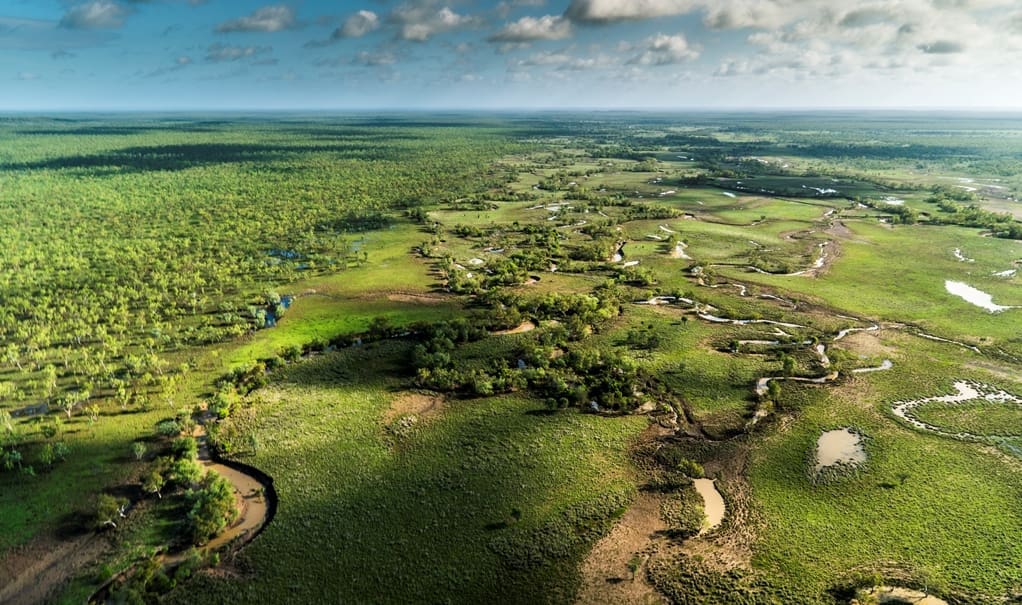
The Northern Territory’s Tanumbirini and Forrest Hill sold last week for $70 million, in the biggest Australian property sale so far in 2020.
MOST grazing regions and commodity classes experienced near or new record prices in 2019, despite the impact of the banking inquiry and adjusted lending conditions.
After a very dry start to the year which was shaping up like an extension of the desperate conditions seen in 2019, the seasonal outlook is now looking much more promising in many grazing areas, and cattle markets have risen sharply over the past fortnight.
The change of fortunes, and solid prospects for more rain over the next eight days, is already injecting a level of confidence back into the property market, industry commentators say.
The industry’s primary cattle market barometer, the Eastern Young Cattle Indicator, has started the year like a rocket, pushing to 620c/kg this afternoon, up 45c/kg in a week and more than 140c better than this time last year.
In our first weekly property review for 2020, industry experts share their thoughts on what’s in store for the year ahead.
Ben Forrest, Resolute Property Group
Ben Forrest from the newly-launched Brisbane-based Resolute Property Group admits it is typical for an agent to be bullish, but thinks that rural property should stay strong in 2020.
“Last year, there was a shortage of good country for cashed-up buyers looking to accumulate. Over the next year or two, and on the back of recent rain, I’m anticipating property listings to increase,” he said.

Ben Forrest
“While the recent seasonal conditions have knocked some buyers around, others are cashed-up and poised to purchase. Good quality A-grade grazing assets will always be in demand, and investors are anticipating good margins once it rains properly,” Mr Forrest said.
He said strong commodity prices were motivating some people to accumulate.
“Some producers who have made some reasonable money over the last few years are keen to achieve that next level of scale. While there is foreign inquiry, domestics are driving the market, some backed by overseas money. I’m now looking forward to seeing the new year kick in, and start to prove itself.”
After speaking with bankers recently, Mr Forrest believes most are happy with their books.
“The banks have become more tolerant, and I’m not expecting a backlash from banks (foreclosures after rain). Many producers who have been waiting for the season to break will make their own decisions. Banks won’t need to make that decision for them,” he said
Stephen Nell – CEO Ray White Rural and Livestock
Stephen Nell, who heads up Ray White Rural and Livestock, said commodity prices for sheep and cattle are still strong, and are influencing both supply and demand.
Mr Nell said despite the poor finish to the 2019 season, there had been some significant sales across the country over the last three to four months.

Stephen Nell
In December, RWR sold the 7230ha Dingo, Central Queensland district property Karamarra (with Mackenzie River frontage) to Western Australia’s Brent Smoothy for between $25m-$30m including water and machinery. RWR also sold the 89,000ha Wagga Wagga Station, 30km east of Yalgoo and 410km north northeast of Perth, to an individual from the eastern states, for about $900,000.
Mr Nell is confident overseas investment will continue this year and that locals will keep buying up.
“It wouldn’t surprise me to see more Australian companies and institutions jostle to secure more significant properties, as has been the trend over the New Year period.”
In January, the North Australian Pastoral Co purchased the 134,000ha Central Queensland cattle breeding and finishing property Mantuan Downs near Springsure. It was one of seven prized grazing assets held by Clark & Tait which were offered to the market under an expressions of interest process in August last year.
Also in January, Queensland integrated beef supply chain and processor, Australian Country Choice, paid $20m to secure the quality large-scale Augathella district grazing aggregation, Gladys Downs. The highly improved 20,000 hectares are estimated to carry up to 5000 mixed cattle in an average season.
2020 Values
In terms of this year’s property values, Mr Nell said they were like water and would eventually find their own levels.
“However, there does come a time when the two don’t add up. There will always be those special properties that buyers are prepared to pay additionally for because of what they are (their reputation), but prices shouldn’t be out of step with productivity,” he said.
Peter Honnef, Jones Lang LaSalle director
JLL valuer Peter Honnef said fundamentally, the 2020 rural property market was looking good.

Peter Honnef
“A lower Australian dollar (currently around US67c, down 3c since early January) makes our product more affordable in overseas markets, which is positive for property prices. It is just another fundamental that indicates it is going to be a good year and that values will be maintained.”
The Townsville-based director identified a number of factors putting upward pressure on values this year, including:
- Affordable finance
- An increasing eagerness by banks to fund acquisitions and gain market share
- Strong global fundamentals for red meat with good demand for produce and an active supply chain to domestic and export markets.
Mr Honnef expects some short to medium headwind on demand and capital from the global coronavirus crisis.
Action by banks?
He doesn’t believe there will be a rash of bank foreclosures after rain.
“There are producers in cropping areas of New South Wales and South Australia who are experiencing their second year of drought. If banks were going to act, they would have done so early last year, because some of those businesses haven’t had an income for two years. I just can’t see it becoming an issue, particularly with low interest rates,” he said.
Martin Tremain, Opteon
Tamworth-based Martin Tremain works with Opteon, providing property valuation and advisory services in the drought-stricken New South Wales regions of the North West, New England Tablelands and Hunter Valley.

Martin Tremain
The property market has been very strong over the last three to four years and despite the recent drought, the market has witnessed some rapid escalations of values in his region, he said.
Mr Tremain is confident 2020 should stay strong for prime quality land.
“Property values are unlikely to drop off. In fact, some areas could experience a slight increase. Second quality land may stabilise or ease back, but generally with demand from corporate to family farming, good quality grazing land in the north will have a pretty good year, despite the conditions.”
Mr Tremain believes most of the major factors influencing the property market are still in good shape.
“Strong commodity prices, a low interest rate cycle and a lower Australian dollar are some of the factors combining to help support the market. Continued interest from local farming families to corporate and institute investment buyers and seasonal breaks (the Tablelands has received some rain, while other areas have had reasonable falls in January) are also contributing to the optimism.”
Despite some relief, the drought is far from over for many. However, when the season breaks, Mr Tremain doesn’t expect there will be a rush of properties to the market as many producers will look to restock (which could take a fair bit of capital).
At this stage, he is confident the 2020 property market will be steady as she goes.
“Last year, there were fewer properties offered and less action. Many assumed the market would weaken, however most transactions were firm (although not as bullish as the previous 12 to 24 months) and surprisingly, there has been no market correction.”
Mr Tremain said prices in the cropping belt have remained remarkably strong, despite two years of failed crops, as have irrigation and places with water.
“The market has been enhanced by demand from many different buyer profiles – family farm operators, off farm investors and internationals. There’s still reasonably good competition for properties, but listings are in short supply.”
Caution over ‘emotionally-driven’ property purchase decisions
Herron Todd White’s monthly property summary released today offers some words of caution for buyers considering an acquisition in western Queensland grazing areas in 2020.
“It is time to be careful and calculating of the risks in buying or selling cattle stations at this stage of the property market cycle,” HTW’s report said.
“A few market comments have started to appear that have not been around since the 2006-08 period. These were bullish comments then, and are indicative of confidence rising now,” it said.
“For some, their investments back then worked. For others, bullish expansions resulted in unfortunate situations. Perhaps the variance in outcomes arose from calculated due diligence processes for the successful manoeuvres, as opposed to emotional acquisitions that stretched all available resources.”
The HTW report said an example of a comment that had recently surfaced again was the classic one: “We need to buy Johnny a property now because property values are rising. Johnny is old enough for a property and we will never get the opportunity again.”
“The resurfacing of such an emotionally-driven reason to buy a property is a reasonable indicator that market sentiment is getting up there.” HTW’s report said.
“The top of the current market cycle may be looming. At this stage, emotionally-driven buyer transitions have been minimal.”
With such a strong southern buyer demand influence seen in north and northwest Queensland last year, potential local buyers knew what price-point reflected their highest bid point.
“This shows that local buyers are doing their homework at this stage of the cycle. They have calculated the price at which they can be profitable and successful. If another buyer outbid them, then so be it.”
Should southern buyer demand dissipate in the ensuing months, vendors also would need to be prudent, HTW said.
“It may be that in the absence of southern buyers, asking for a price increase on 2018-19 values may not achieve a successful sale in the North Queensland region,” it said.
“In this stage of the market cycle, both buyers and vendors need to be prudent. Certainly, with cattle prices looking good and interest rates low, graziers are looking to grow and expand their operations.”
